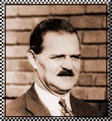
At six feet and one-hundred-ninety-five pounds, Louis Chevrolet cast as long a shadow in life as he did across the early history of the automobile. His career would take him from the early days of the French auto industry, through the tortuous halls of American capitalism and across the bricks and boards of American auto racing. Few present at the birth of the automobile would leave behind such a rich legacy.
Born in La Chaux-de-Fonds, Switzerland, in 1878, Chevrolet, like so many auto pioneers, was drawn to the bicycle and by his teens had proved himself a skilled racer. One day, he was seduced by a de Dion powered tricycle and soon joined that firm, where his apprenticeship took him to Mors and then Darracq. By the turn of the century, he was in New York, working at de Dion's Brooklyn office. In 1905, he jumped to FIAT, where he earned his first racing victory against the infamous Barney Oldfield.
Chevrolet joined Buick's racing team in 1909 at the invitation of William Durant, the founder of the General Motors empire. Durant's confidence was quickly rewarded with a victory at the 400-mile Cobe trophy race in Crown Point, Indiana, but after a severe crash in the 1910 Vanderbilt Cup, Durant pulled Chevrolet off the track. In the midst of wrestling for control of the fledgling GM empire, Durant needed a new car to sell. While Durant may have been looking for volume and profits, Chevrolet was looking for speed and glory and it was hardly with shame that he told Durant of testing the six-cylinder prototype in the wee hours of the morning, passing 100 mph at one point before being thrown in jail.
That first Chevrolet was a success, but its evolution revealed much about Chevrolet and his sponsor. Perhaps the best example of this was their choice in tobacco. While Chevrolet liked cigarettes, Durant preferred cigars. During a discussion about a lowpriced model one day, Chevrolet recalled years later, "I lit a cigarette and he immediately offered me one of his own cigars with a comment that I shouldn't be 'so damned stubborn.' That's when I walked out."
Chevrolet returned to racing, but this time with a car of his own. With his brothers Gaston and Andre along with Albert Champion and Joe Boyer, Chevrolet formed the Frontenac Motors Corporation (named for the 17th century governor of France's North American colonies), and embarked on the construction of three cars for the 1916 Indy 500. The Indy run was a rout, but Chevrolet's luck started to turn when he took flag on the Uniontown boards h1 December. The 1917 season was strong as well, with wins in Providence, Sheepshead Bay and Chicago. But when racing resumed after the wartime hiatus, Chevrolet's fortunes ran out with just $3200 to show for the team's 1919 efforts. The crowning blow was a reduction in maximum displacement to 183 cubic inches for the 1920 season, rendering Chevrolet's 300-cubic-inch cars obsolete.
But just as his venture seemed on the brink, a Chevrolet dealer in Indianapolis took control of the Monroe Motor Company and asked Chevrolet to run his racing team. With former Duesenberg engineer Cornelius Van Ranst now part of the team, Chevrolet moved his operation to Indianapolis, preparing eight 183-cubic-inch cars.
Chevrolet's younger brother, Gaston, took the flag, becoming the first driver in Indy history to go the full 500 miles without a tire change. Chevrolet and Van Ranst would build on their success the following season with an all-new twin-cam straight eight. Tommy Milton, fullfilling a long-held dream of victory at the brickyard, brought the field home at an average speed of 89.62 mph. Those two victories, won with two different engines, would always be a tremendous source of pride for Chevrolet.
Although 1921 was the last Fronty win at Indianapolis, Chevrolet turned to other interests. He and Van Ranst found a new niche fitting overhead valves to Model T engines, creating virtually unbeatable dirt-track racers. With his attention focused on the tremendous success of the Fronty-Ford operation, however, Chevrolet's 1922 run at the brickyard was a disappointment, with only one of six cars making it to the finish.
In later years, Chevrolet would dabble in boat racing and begin work on a lightweight aircraft engine for Glenn Curtiss, but the Crash undermined his financial footing. He died in June, 1941. Today, an impressive monument to his accomplishments stands on the grounds of Indianapolis Motor Speedway. Below his bust are engraved the words, "Never give up." Louis Chevrolet never did.